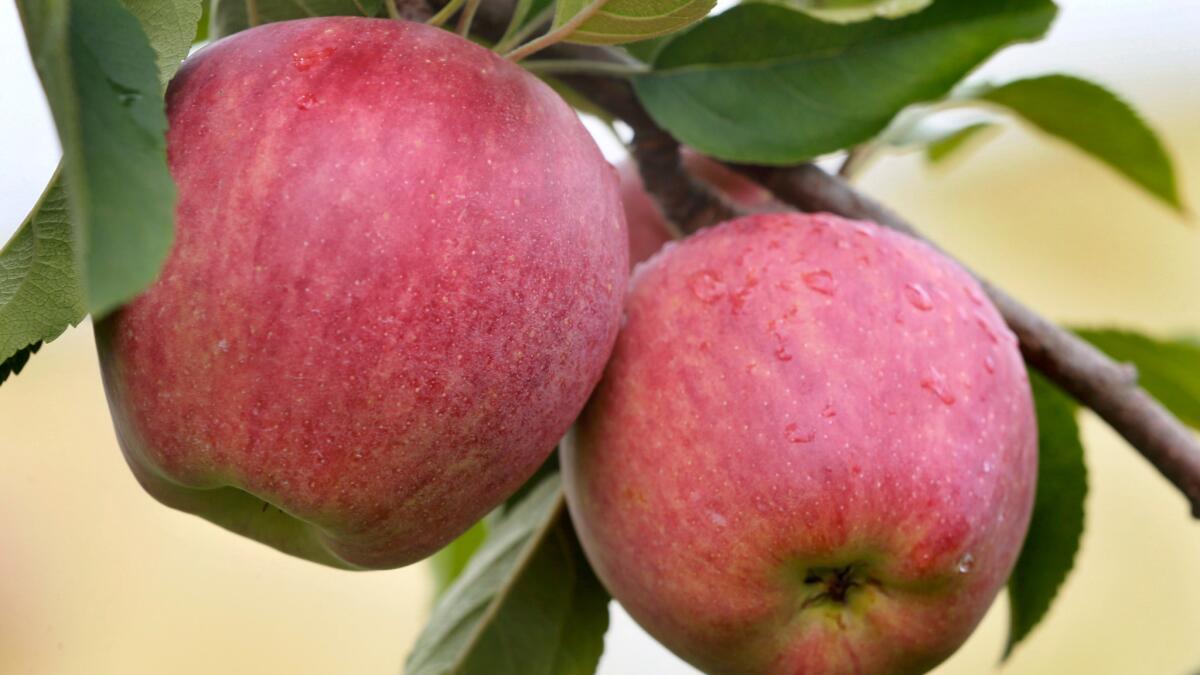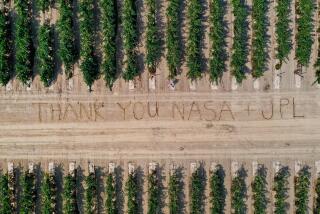Smartphone app uses science to tell you whether your apple is ripe for eating

- Share via
Scientists have developed a handheld device that uses a tiny sensor to instantly determine the ripeness of a piece of fruit — no squeeze test necessary.
It could be a game-changer for grocery shoppers who feel the need to fondle several pieces of fruit in the store before deciding what ultimately makes it into the shopping cart. (You know who you are.)
The new instrument, described this week in Scientific Reports, is a small and inexpensive spectrometer, which can be constructed for just under $250 and interfaces wirelessly with a smartphone.
A spectrometer is a scientific tool that splits light signals into many components. Scientists use it to measure light that is emitted, absorbed or scattered by materials, which in turn helps them identify and study those materials.
Astronomers use spectrometers to determine the chemical makeup of stars, planets, comets and asteroids. Geologists use them to understand the composition of terrestrial rocks. They can also be used to study certain types of bacteria and other biological compounds that emit light.
Spectrometers have traditionally been quite expensive, costing several thousands of dollars. They have also generally been too large to use outside of a laboratory setting and require a laptop to operate.
To shrink the instrument, the research team incorporated a spectrometer chip made with micro-electro-mechanical systems, or MEMS, technology that has drastically reduced the size of spectrometers. This allowed the team to build the first research-grade spectrometer that is about the size of a typical garage door opener.
To test its effectiveness, the science team decided to see how well it was able to detect the ripeness of a piece of fruit.
It turns out there is a relationship between the ultraviolet fluorescence of chlorophyll in the skins of fruits like apples, oranges and bananas and the softness of the fruit inside. Using a spectrometer to measure the fluorescence of chlorophyll allows scientists to tell whether the fruit is ready to eat, or if it could use a few more days to reach prime sweetness.
Although spectroscopy has not yet been used to determine fruit ripeness in the field, it has frequently been used in the lab.
“Ripeness testing using spectrometers is non-destructive and very fast,” said Anshuman Das, a postdoctoral researcher at the MIT Media Lab and coauthor of the new study. “It does not involve much sample preparation, so it’s an attractive approach.”

For their study, Das and his colleagues used the device on about 100 apples.
For each test, they held the spectrometer against the skin of the fruit and then activated an LED light built into the device. The chlorophyll in the apples’ skin re-emitted the light in an ultraviolet wavelength that was measured by the instrument. Those measurements were sent to a smartphone, which was able to analyze the information and determine whether the fruit was ripe.
To see if the device was effective on all types of apples, the researchers ran experiments on three varieties with different coloration patterns.
The spectrometer-cum-ripeness-detector worked best on Golden Delicious apples because their green and yellow skin has the most chlorophyll and gives off the strongest fluorescence signal.
Next came mixed-colored McIntosh apples, which have regions of red and green. The device did a better job of determining ripeness when aimed at the green spots rather than the red ones.
Finally, the researchers tested Empire apples, which are entirely red and thus had the largest concentrations of pigments that can mask the chlorophyll signal.
Das said the group’s spectrometer worked the worst on the red apples, but added that he and his colleagues are already working on new techniques that could improve these results.
The study authors say their new device could help farmers determine the optimal time to harvest fruit, or help them rapidly sort apples in storage facilities based on their ripeness. Consumers might someday use a mini-spectrometer to “see” how ripe a piece of fruit is without touching it, or to identify bruising or other damage that is not visible to the naked eye.
Das said the device could have lots of other applications, too. It’s possible that it could be used by geologists in the field, educators in the classroom, and even healthcare professionals to diagnose medical conditions in patients who live far from a lab with a traditional spectrometer.
The team has no plans to bring it to market anytime soon, but they have released an open-source platform with all the information needed to replicate and further develop the device.
“Today you can build things in your garage that could have only been built by researchers or large companies a few years ago,” Das said. “We hope that the community will help expand its capabilities.”
Do you love science? I do! Follow me @DeborahNetburn and “like” Los Angeles Times Science & Health on Facebook.
MORE IN SCIENCE
Millennials are more politically conservative than Baby Boomers or Gen X’ers were at their age
NASA study of twins Mark and Scott Kelly examines biological limits of sending humans to Mars
Elusive Philae lander spotted on Rosetta’s comet one month before mission’s end






